In what will be a very good tune-up for their home World Cup in two years’ time, the United States are participating in this year’s edition of the Copa América, also taking place on home soil.
After a 2022 round of 16 World Cup exit at the hand of the Netherlands, there was the potential for plenty of change for the USA national team, with head coach Gregg Berhalter’s contract expiring and the United States having an interim in charge for an extended period.
After a long and arduous process of looking for a new head coach, the Federation eventually settled back on Berhalter, with the 50-year-old signing a new contract until the end of the 2026 World Cup.
The expectations for the United States are rather high going into this tournament, and a lot of eyes will be on how they perform against some of the biggest sides in Central and South America.
This tactical analysis will take a detailed look at Berhalter’s side, as well as predict how they will do this summer.
Predicted starting XI
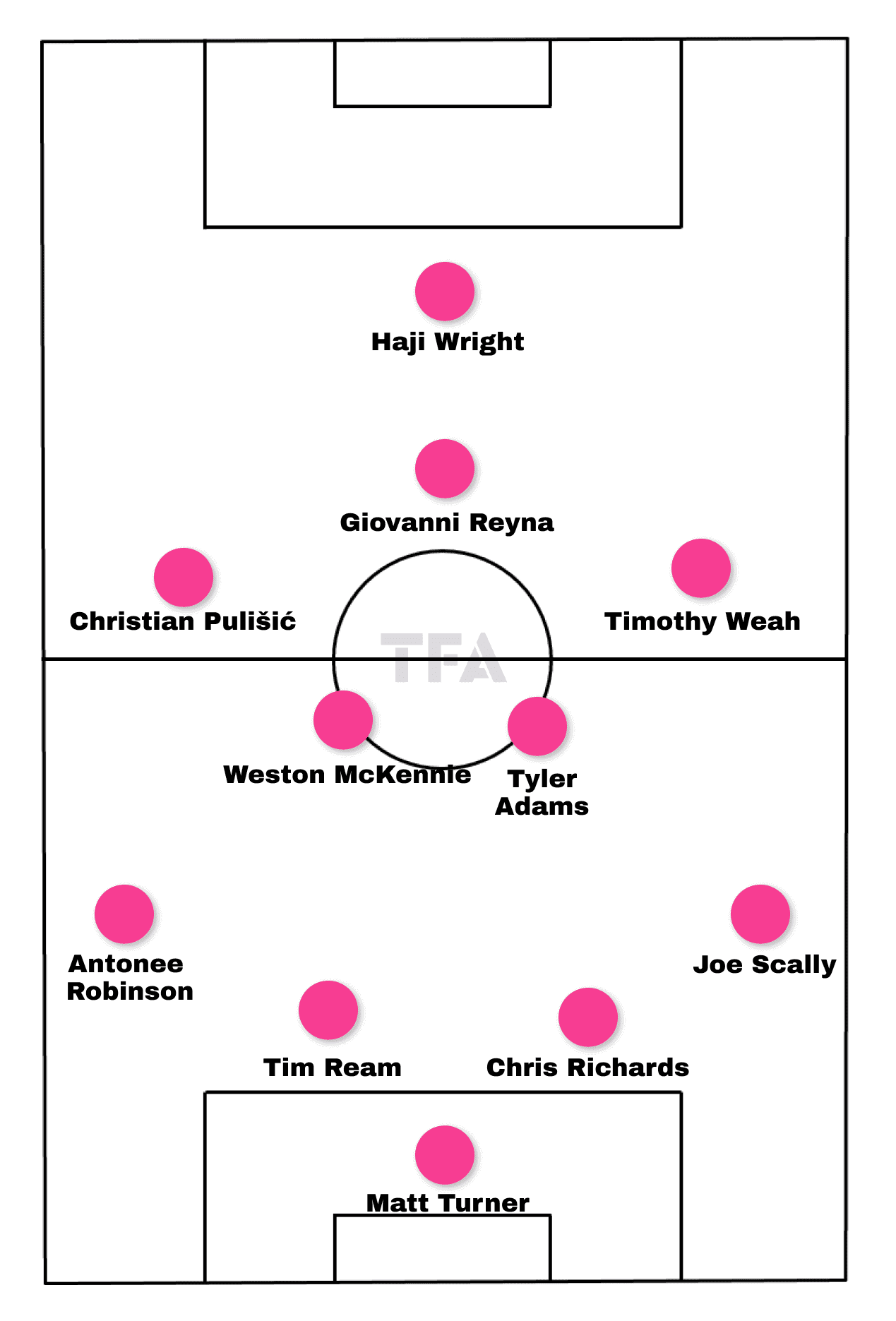
Berhalter will have plenty of options come this summer.
It was recently announced that the Copa América is allowing expanded squads to 26 players, similar to what the European Championships are doing as well.
In goal, it is likely Berhalter will stick with Matt Turner.
Even though the Nottingham Forest goalkeeper has not played recently, he still seems the favourite to get the nod over Ethan Horvath, who has established himself as Berhalter’s #2 choice in goal.
In the fullback positions, usual starter Sergiño Dest will be missing this tournament after tearing his ACL recently with PSV Eindhoven.
This means it could be an open battle as to who replaces the 23-year-old.
We have predicted that taking his place on the right is Borussia Mönchengladbach fullback Joe Scally, with the 21-year-old starting in 31 Bundesliga matches for the German side.
At left fullback, Antonee Robinson seems locked in as the starter on this side.
Berhalter wants his fullbacks to get forward in attack, with the players in these positions typically tasked with offering width in the attacking third, as the wingers/wide midfielders tend to invert, though sometimes these roles are reversed.
Kristoffer Lund and Shaq Moore could also be options in these positions, with both players making Berhalter’s provisional squad for the tournament.
Tim Ream and Chris Richards look like the likely centre-back pairing at centre-back, with both players playing rather substantial roles in their club sides, Fulham and Crystal Palace, respectively.
Both players have had rather prominent roles for their club sides this season in the Premier League, with Chris Richards having a more significant role once the South London club appointed Oliver Glasner.
Celtic’s Cameron Carter-Vickers and FC Cincinnati’s Miles Robinson should offer Berhalter good options off the bench, with the potential for one of these two to nab a starting role once the tournament kicks off.
Midfield is where Berhalter’s most interesting decisions, firstly starting with formational setup, may lie.
We have predicted the United States using a 4-2-3-1, but there is a chance it starts as a 4-3-3, or at least looks like it once the match kicks off.
The two deeper-lying midfielders essentially put themselves in the starting XI, with Juventus’s Weston McKennie and Bournemouth’s Tyler Adams being the likely double pivot for Berhalter.
The central #10 position is where there may be some debate internally and externally.
If Berhalter opts for a 4-3-3, there is a chance AC Milan’s Yunus Musah occupies the final starting midfield spot, but Gio Reyna’s fine recent form for the national team means we have selected him to get the nod, starting in a more advanced midfield role.
USA captain Christian Pulišić and Timothy Weah get the nod in the wide midfielder positions.
Moving to the centre-forward position, and this is where we have a surprise inclusion.
While it still seems likely Berhalter will opt to start with AS Monaco’s Folarin Balogun up top, we have included Haji Wright as the starting centre-forward.
Based on current form, the Coventry City forward deserves the starting spot, with 16 goals, seven assists in the Championship this season, and a crucial goal in the FA Cup semi-final against Manchester United.
Josh Sargent also had a good season for Norwich City, with 16 goals in the Championship as well, but is nursing a slight injury.
Whatever decision Berhalter does go with for the centre-forward position, there are three solid options that could put the ball into the back of the net.
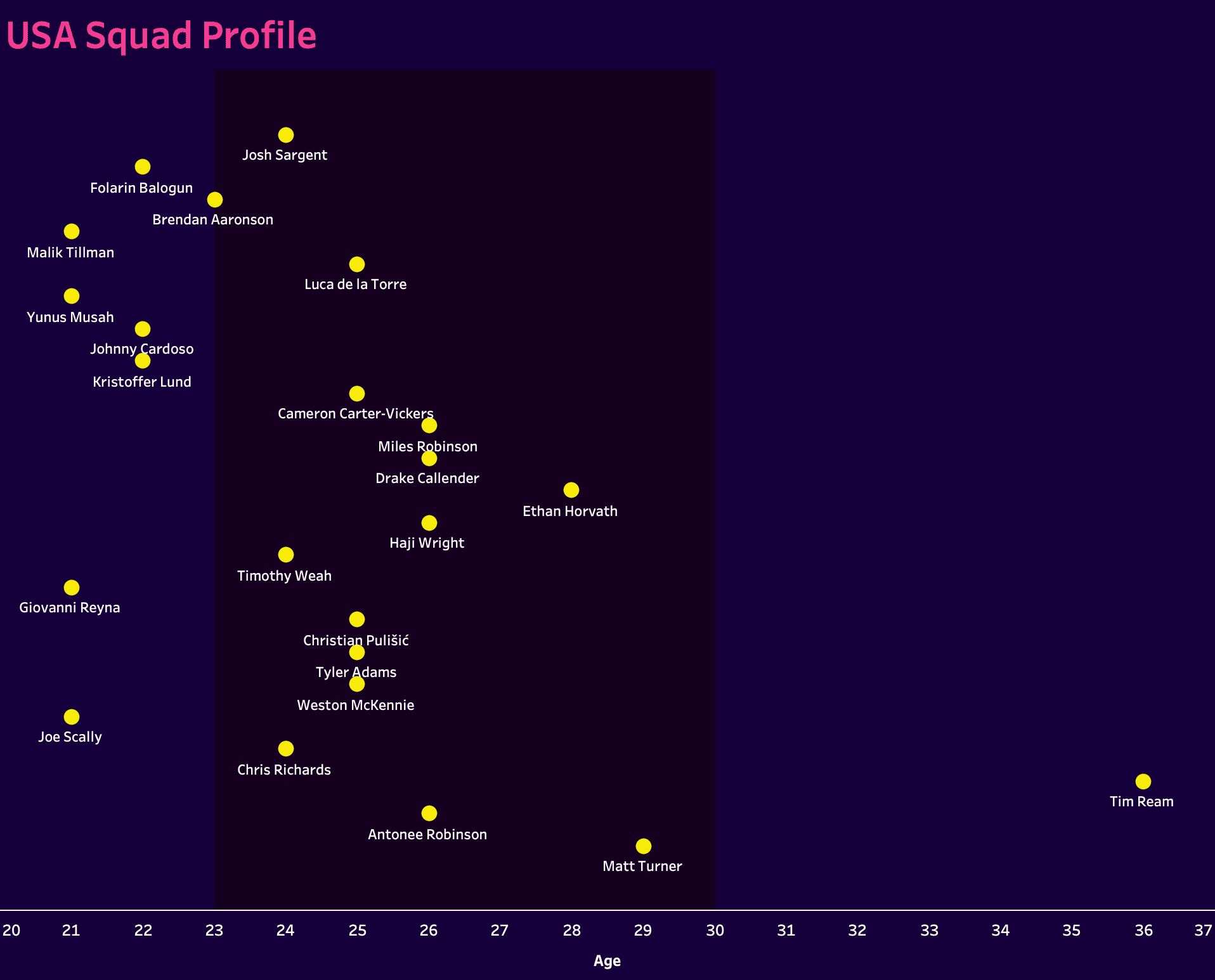
When talking about the squad depth for the USMNT, the squad age profile above gives us a bit of an idea of how the squad may look come the start of the tournament.
One thing to note off the top is that this does not have 26 players, as the decision to expand the squads was just recently announced.
The United States will likely be one of, if not the, youngest squad at this year’s Copa América, with Tim Ream the only player over the age of 30 in the squad.
This is a very young squad, with the majority of the players being 26 or younger.
Many see this tournament as a good indicator of their maturation process, leading up to the home World Cup, which will be staged two years from now, in 2026.
It should also be noted that while this squad is very young, there is also plenty of experience, with most of the players including regular starters or frequent contributors in the top seven or eight leagues in European football.
Attacking phase
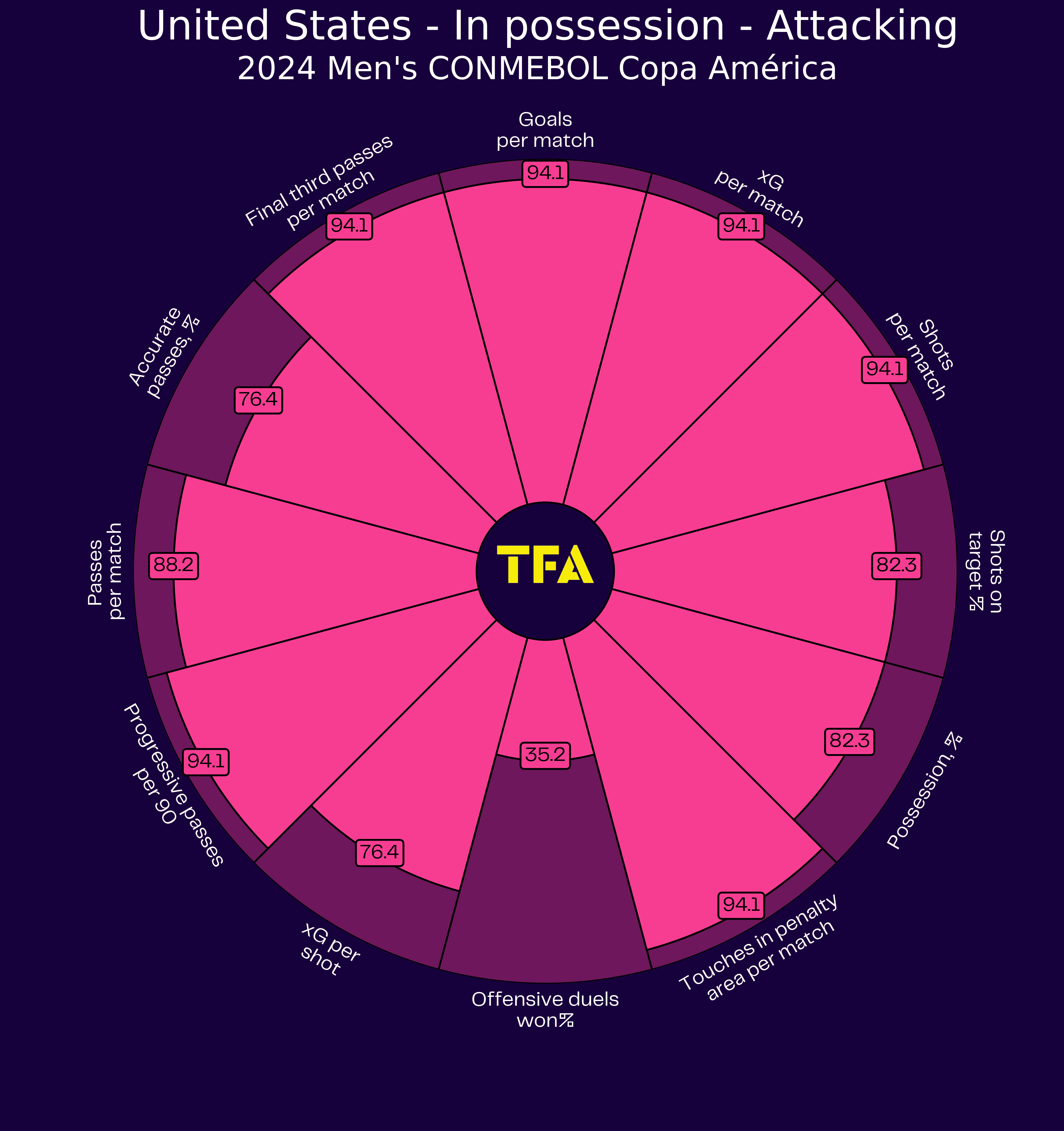
From the graphic shown above, it is evident how the United States look to play under Gregg Berhalter in the attacking phase of play.
The United States looks to play a possession-oriented game, with plenty of movements off the ball and rotations in advanced areas.
Both fullbacks are heavily involved in getting forward and joining the attacking phase, with them usually responsible for holding the width while the wingers look to invert.
One of the deeper lying midfielders will sometimes drop into central defence and form a back three, with the goal in attack to overwhelm the opposition’s defence by the amount of numbers pushed into the attack, as well as rotations to open gaps for players to run behind the defence.
When it comes to progressive passes per 90 minutes and final third passes per 90 minutes, the United States ranks in the 94th percentile, with Berhalter looking for his side to emphasise verticality when they are in possession.
This is also illustrated by their ranking in the 94th percentile for touches in the penalty area per match.
They also rank highly in shots per match and percentage of shots on target per match, showing the clinical nature they display in front of goal.

The image above shows how the midfield three look to interact with the backline during build-up phases for the United States that start with the goalkeeper.
They tend to build with just the two centre-backs staying at home, with both fullbacks already gone and in the attacking half of the pitch.
Instead of keeping one fullback deep and creating what looks like a back three and one midfielder staying deep to assist, the United States tend to have all three midfielders stay in the defensive half to assist during build-up attacking phases.
The midfield three of Reyna, Adams, and McKennie all stay deep in this example above against Mexico, with this tactical nuance from Berhalter forcing the opposition to commit more numbers than they would like in their attacking half of the pitch, which is done to prevent the United States from easily being able to build between their first two lines.
What this, in turn, does is frees up the front three of the United States, plus the two fullbacks, to be 5v4 against the opponent’s backline, allowing the midfielders to receive possession and look to turn and quickly play progressive passes into the wide channels and half spaces, where the wingers and fullbacks are occupying.
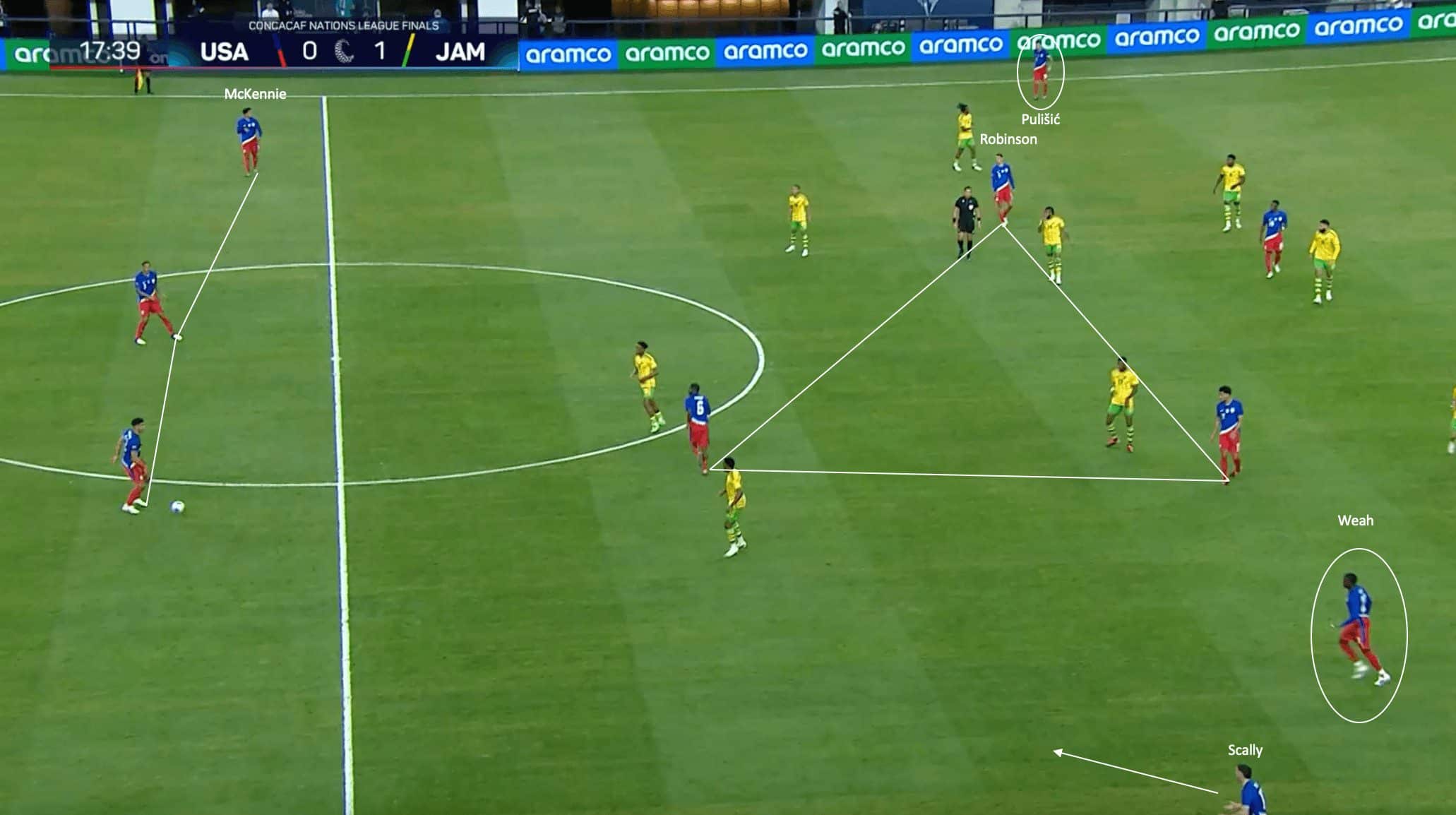
The image above again shows how the United States looks to attack, and more specifically, the rotations in the advanced areas and the tendency for the fullbacks to push forward into the attacking half of the pitch.
As we mentioned earlier in this tactical analysis, one of the central midfielders will occasionally drop into the backline to form a back three, with the fullbacks pushing forward to generate width in attack.
Fullback Antonee Robinson inverts on the far side, taking up Weston McKennie’s position in central midfield and keeping this shape intact.
AC Milan’s Christian Pulišić stays wide, keeping the width, while on the near side, Joe Scally is operating in a wider position while Timothy Weah inverts, dropping into a pocket of space in midfield to receive possession from the centre-back, with Weah becoming the free player in midfield to receive possession and progress play.
After receiving possession, Weah has the space to turn and drive towards goal, with plenty of numbers already advanced in the attacking half to support.
In attack, the United States are a possession-oriented side that has been very clinical in front of goal.
Their midfield rotations and movement off the ball in advanced areas will cause opposition defences troubles.
Defensive phase
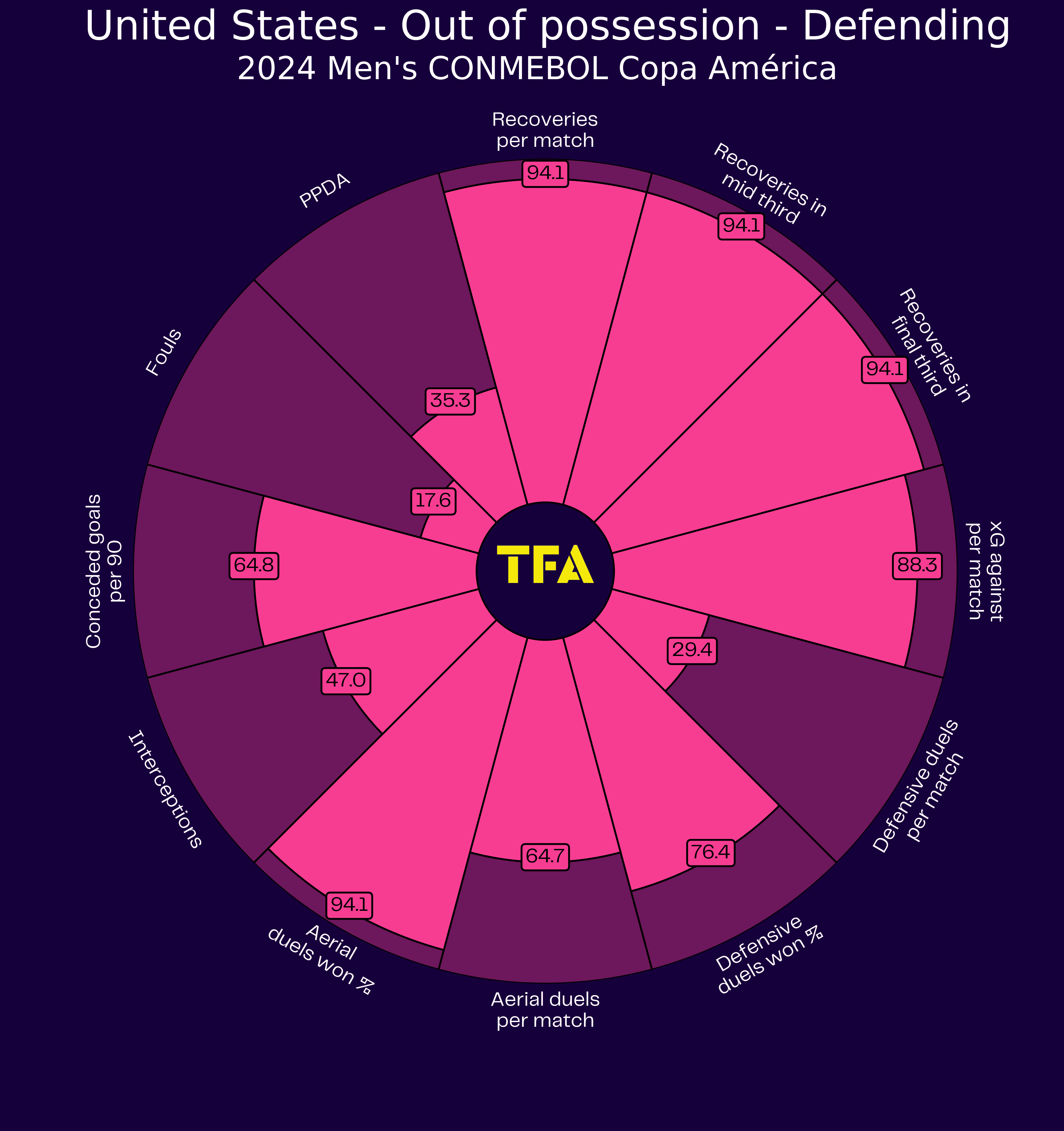
When talking about the United States from a defensive standpoint, they have tended to be a solid defensive side and do not concede many goals.
Berhalter’s side ranks in the 88th percentile for xG against per match, highlighting the solid defensive foundation that has been developed.
From a pressing standpoint, they are not the most aggressive side, with their PPDA only ranking in the 35th percentile.
They do make plenty of recoveries per match, with the United States ranking in the 94th percentile for total recoveries per match, recoveries in the middle third per match, and recoveries in the final third per match.
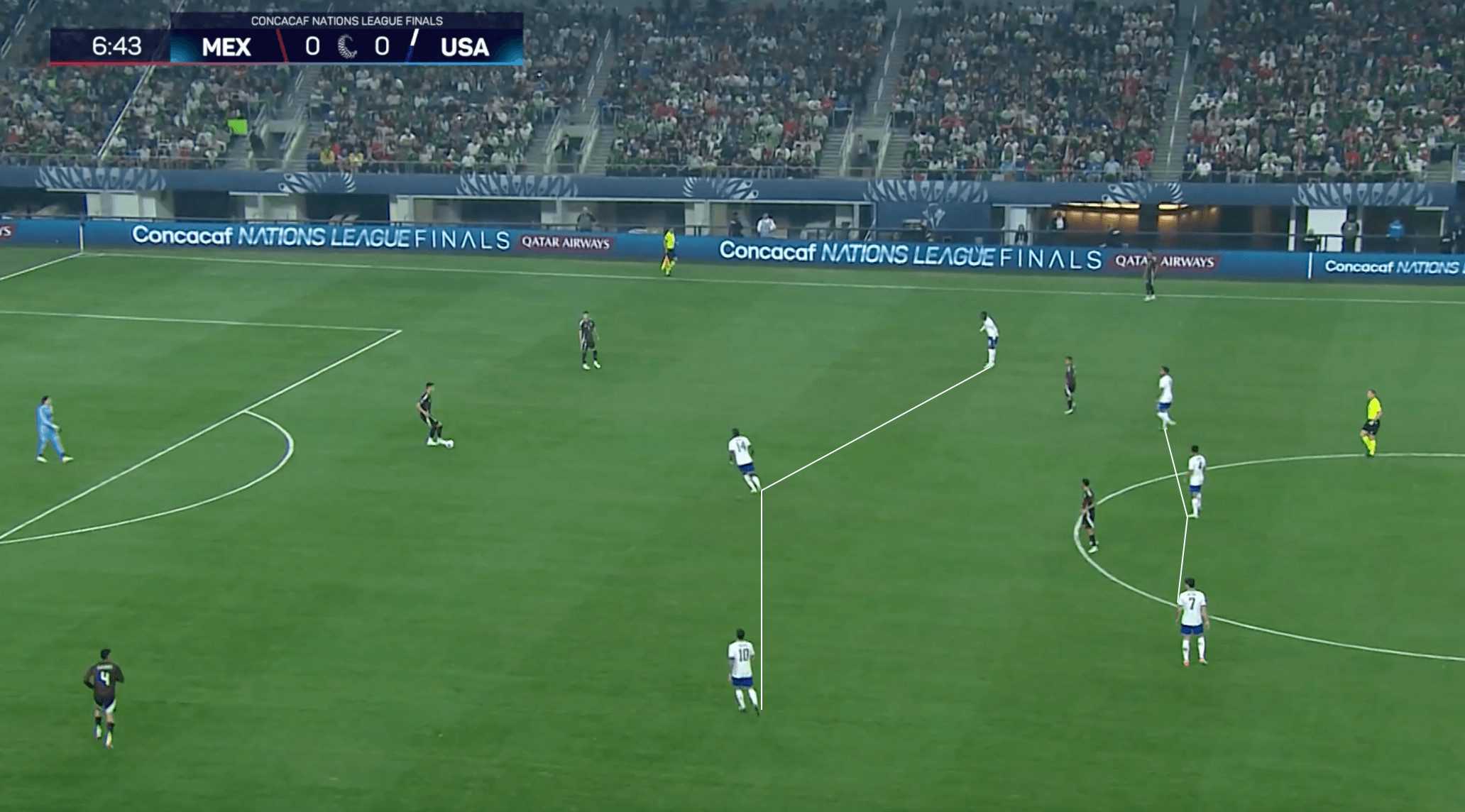
When it comes to defending from the front, we just saw how the United States do not rank highly in PPDA, with Berhalter’s side tending to opt for a more man-marking approach when defending with the first two lines of pressure.
As we can see from the above image, the out-of-possession shape tends to look like either a 4-3-3 or potentially a 4-2-3-1, with Berhalter opting for a defensive approach focused on eliminating central progression.
This narrower defensive shape also prevents opposition sides from building through the central areas, with the United States looking to force the ball into wide channels or long channels, where they can collapse and recover possession to counterattack.
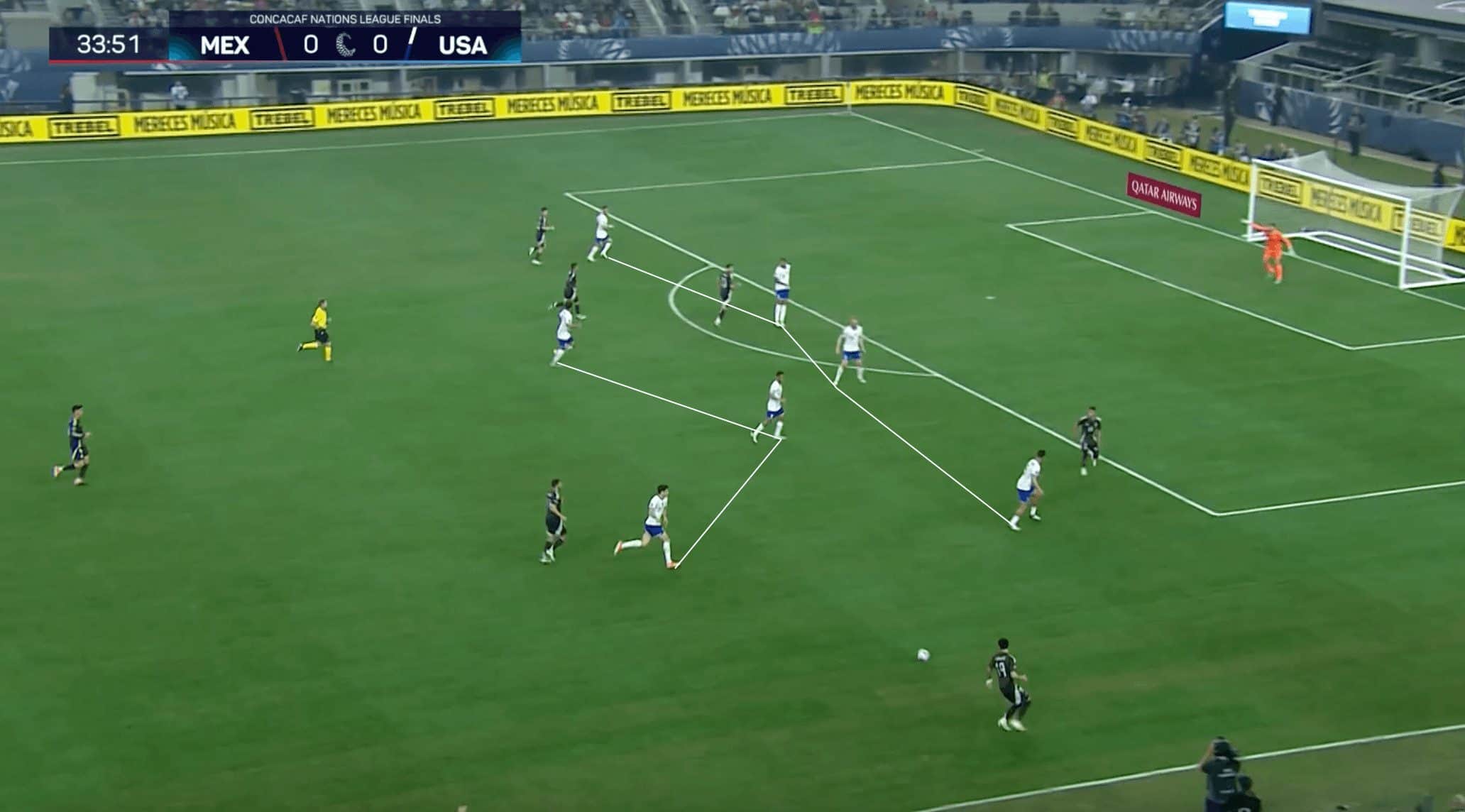
The United States ranks in the 65th percentile for conceded goals per match, so they are above average when it comes to a defensive standpoint and conceding goals.
We already mentioned how they do not give up much xG per match to their opponents, with their defensive shape in and around their penalty area key to this.
We can see in the figure above how the USA’s box-defending shape looks when the opposition can progress the ball into the final third.
The back four gets compact and narrow, with the two defensive midfielders typically dropping back as well to support in the defensive phases.
In this defensive phase above against Mexico, the winger has also dropped to support and put pressure on the player in the wide area.
In the central area, both Adams and McKennie have dropped to support the back four, with their positioning forcing the opposition to play into the wide channels and looking to eliminate any possibility of central progression, with Mexico eventually forced to play back to midfield, allowing the United States defensive shape to step up.
The United States are not an air-tight defensive unit, with them prone to conceding goals.
However, they do not give up many high-quality goalscoring chances, as illustrated by their high percentile ranking for xG conceded per match, and make plenty of recoveries per match to start dangerous counterattacking moments.
Transitions
While the United States tend to opt for a more possession-based approach when attacking, they also have the ability to be lethal in transition.
The pace of the wingers and quick forward-thinking progression of the midfielders after possession turns over in the midfield are vital to the threat they are able to cause in transitional moments.
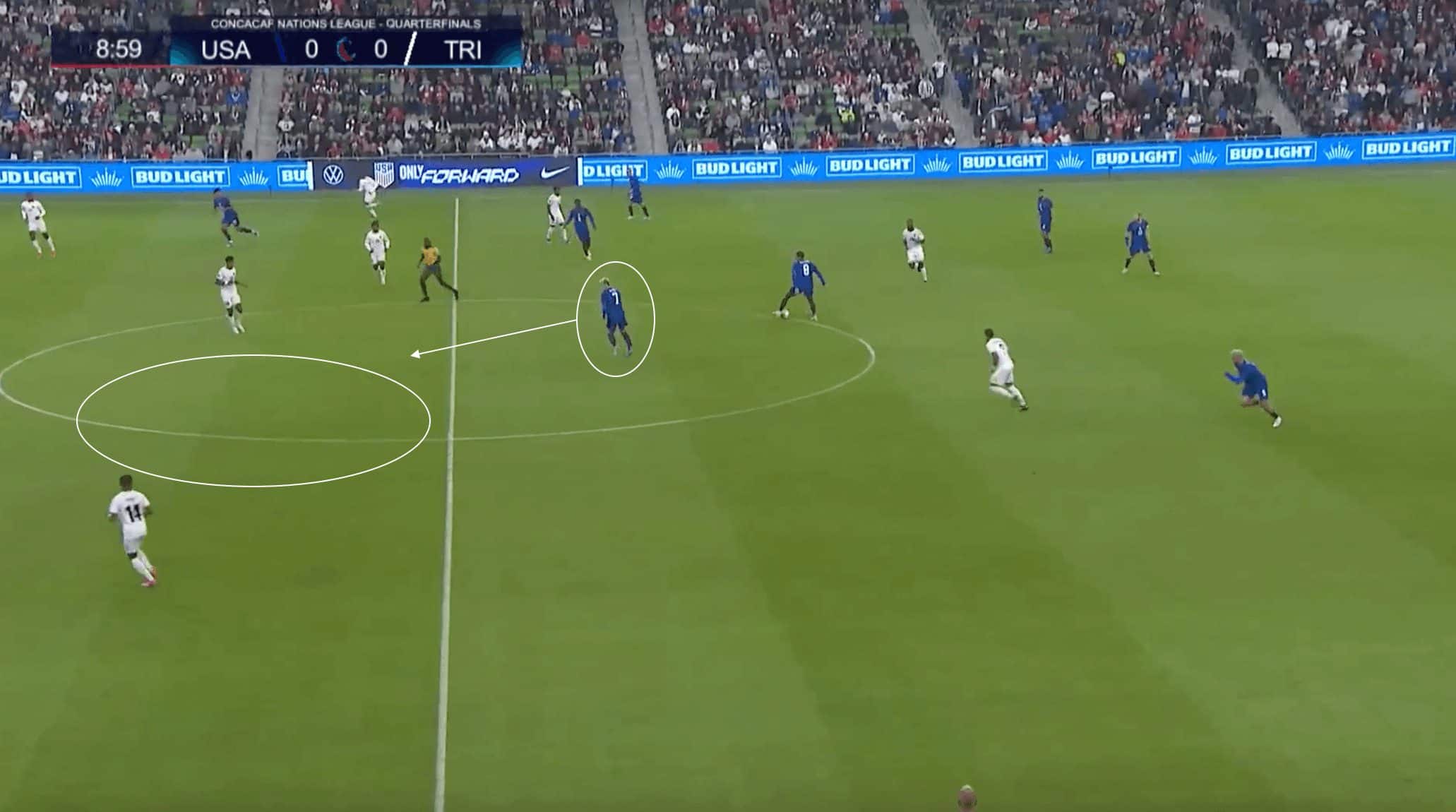
From the figure above, we can see how the United States attack opponents in transitional moments.
A lot of their chance creation in transitional moments come from the midfield areas, with the image above a good example of this.
After the ball is turned over by Trinidad & Tobago, the ball is able to find its way to McKennie in the United States midfield.
He is able to quickly turn and find Gio Reyna, with the attacking midfielder able to turn and drive into the vacant space in midfield.
After driving into the space left in transition by the opposition defence, Reyna is able to play a ball into Kevin Parades in the wide channel, with the advancing winger able to drive into the opposition penalty area.
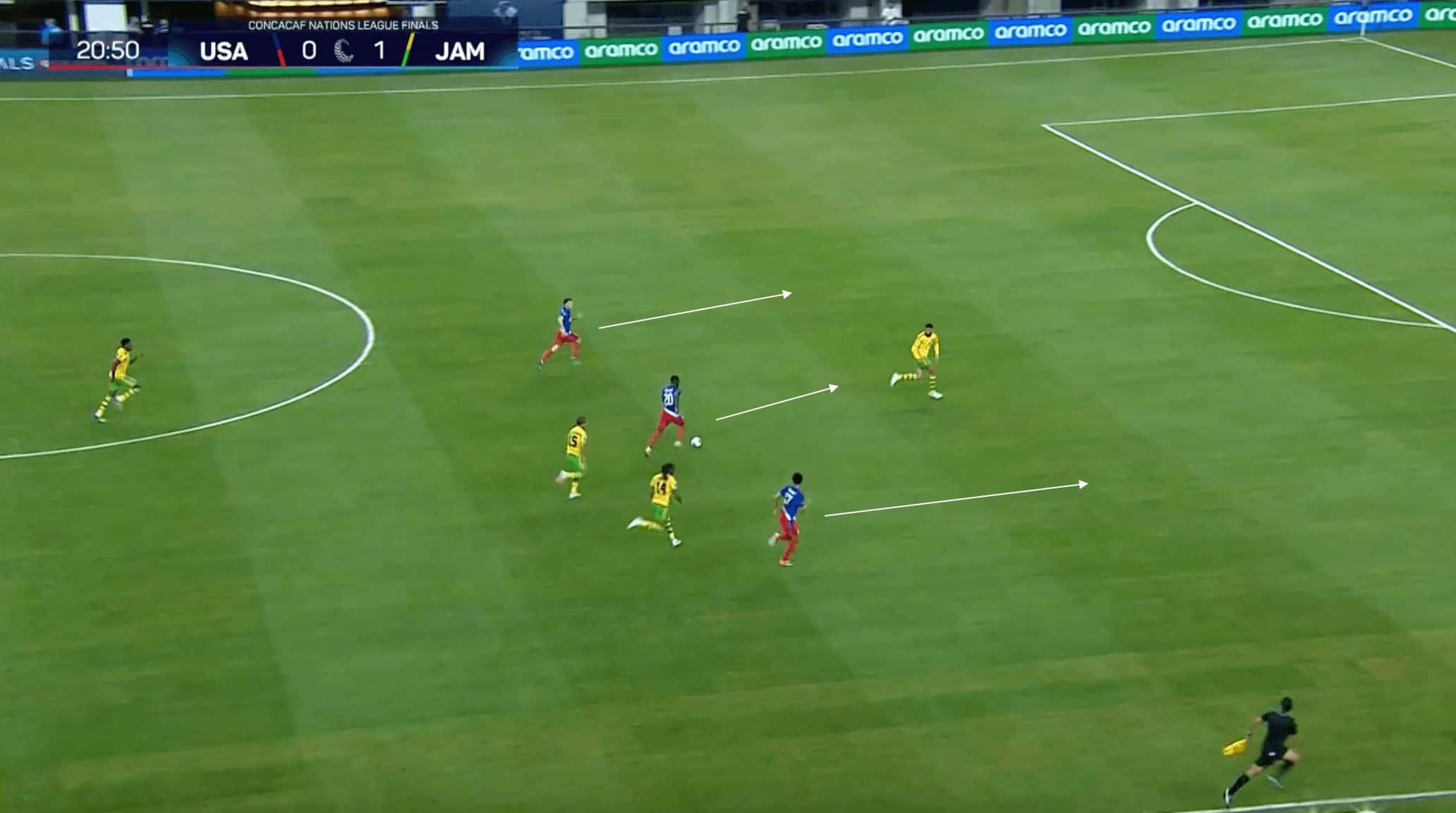
The United States have also shown the ability to be a large threat on fast-break counterattack moves, with this phase of play above against Jamaica showing a good example of their pace on the forward line in transitional moments.
The Jamaican midfielder gets caught in possession near midfield by Malik Tillman, allowing the United States attackers to run at the Jamaican defence.
While this counterattacking moment does not result in a goal for the United States, it shows the danger they are able to possess in these fastbreak transitional moments.
While they are a much more possession-oriented side under Gregg Berhalter, they are still able to cause a viable and dangerous threat when possession is turned over in the middle third of the pitch.
Forwards
The forwards, and more specifically, the centre-forwards, at Gregg Berhalter’s disposal, will need to score goals.
At club level this season, Balogun, Wright, Sargent, and Ricardo Pepi, if he makes the squad, have all been able to put the ball in the back of the net.
Starting with Balogun, the AS Monaco forward has scored 10 goals in all competitions for the principality side this campaign, averaging 3.08 shots per game and 41.8% being on target.
Haji Wright has arguably had the best club campaign of any USMNT forward, with the Coventry City man scoring 20 goals in all competitions this season.
However, he has yet to be as consistent in putting shots on target, with Wright only averaging 2.93 shots per match this season and only putting 37.1% of them on target.
Pepi has scored 12 goals in all competitions for PSV Eindhoven this season, albeit in a more limited role for the Dutch champions.
He has averaged 2.76 shots per match, with 52.5% being on target.
Sargent is probably one of the more interesting potential centre-forward names for Berhalter.
The 24-year-old has scored 17 goals in all competitions for the Championship side, with 2.66 shots per match and a 50% on-target percentage.
Midfielders
When it comes to the central midfielders for the USMNT, they will be tasked with progressing the ball to the forwards, with McKennie and Adams tasked with not only breaking up opposition attacks in the central midfield areas but also with being deep-lying playmakers for Gregg Berhalter.
For Juventus this season, Weston McKennie has six assists in Serie A, while he has also made 14 key passes from a deeper lying midfield role.
Adams was hurt for a good chunk of the season with Bournemouth.
Still, he has shown his capabilities in previous seasons as a deep-lying playmaker.
The attacking midfielders for the USMNT are not only responsible for creating chances and scoring goals, but they are also going to be tasked with taking opposition defenders on with the ball at their feet and getting past them into more advanced positions to send crosses in from the wide areas and half-spaces.
USMNT captain Christian Pulišić has had a new lease of life since moving to AC Milan, and he has been a prolific dribbler this season.
The 25-year-old has averaged 6.5 dribbles per 90 minutes this season, with a success rate of 58%.
Gio Reyna is another player who has not had the best season at club level, with the 21-year-old having limited opportunities for Nottingham Forest since moving on loan from Borussia Dortmund.
Still, he has demonstrated his dribbling ability in the past, with Reyna also being in great form for the national team in recent appearances.
Timothy Weah has averaged 2.48 dribbles per 90 minutes for Juventus this season.
Defenders
Though it is rather obvious, excelling defensively is going to be essential for the back four of the USMNT at this summer’s Copa América.
Looking at the likely back four for Berhalter at this tournament, they are all very competent defenders.
Antonee Robinson has been one of Fulham’s best defenders this season, with the 26-year-old fullback averaging 8.73 defensive duels per 90 minutes, with a success rate of just under 63%.
Moving inside to centre-back and his club teammate Tim Ream.
The 36-year-old has had a less impactful role on the Premier League side this campaign, with Ream averaging 3.94 defensive duels per 90 minutes and a success rate of almost 67%.
Chris Richards has put together a very good campaign for Crystal Palace, and the centre-back has been able to excel from a defensive standpoint.
Richards has averaged 5.5 defensive duels per 90 minutes, with a very high success rate of 72.6%.
At right back, this is where Berhalter may have some questions, with us predicting Joe Scally will replace the injured Dest.
Scally has been a consistent starter for Gladbach in the Bundesliga this season, with the 21-year-old averaging 5.8 defensive duels per 90 minutes, with a success rate of just over 55%.
Key player
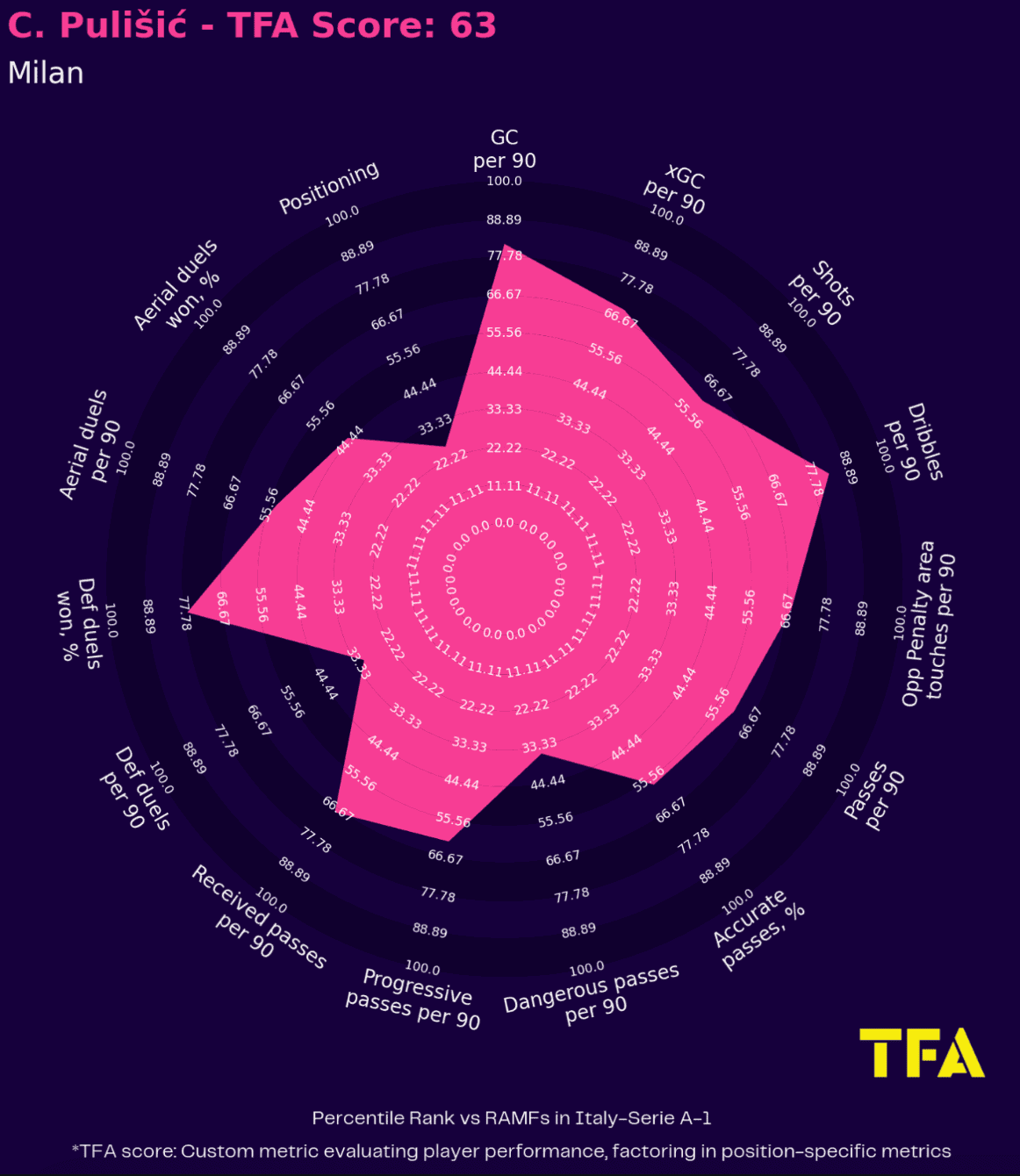
When trying to find a key player for the USMNT, it is hard to look past national team captain Christian Pulišić.
When taking a look at the radar of the AC Milan attacker above, we can see the areas where he excels and where he may make the biggest impact for the United States this summer.
The 25-year-old ranks near the top of the percentiles in both dribbles per 90 and goal contributions per 90, with this being the areas of his game where the United States hope he will contribute the most.
Pulišić will also contribute defensively, with the attacker ranking close to the 80th percentile in the percentage of defensive duels won.
This shows that Pulišić will contribute on both sides of the ball, and he will have to at this tournament if the United States wants to win it all this summer.
Tournament prediction
The United States were placed in Group C of the Copa América, with them matching up against Uruguay, Panama, and Bolivia.
It will likely be a two-horse race with the United States and Uruguay for top spot, with the slightly increased quality of Uruguay meaning we predict the United States will finish second and advance to the knockouts of the Copa América.

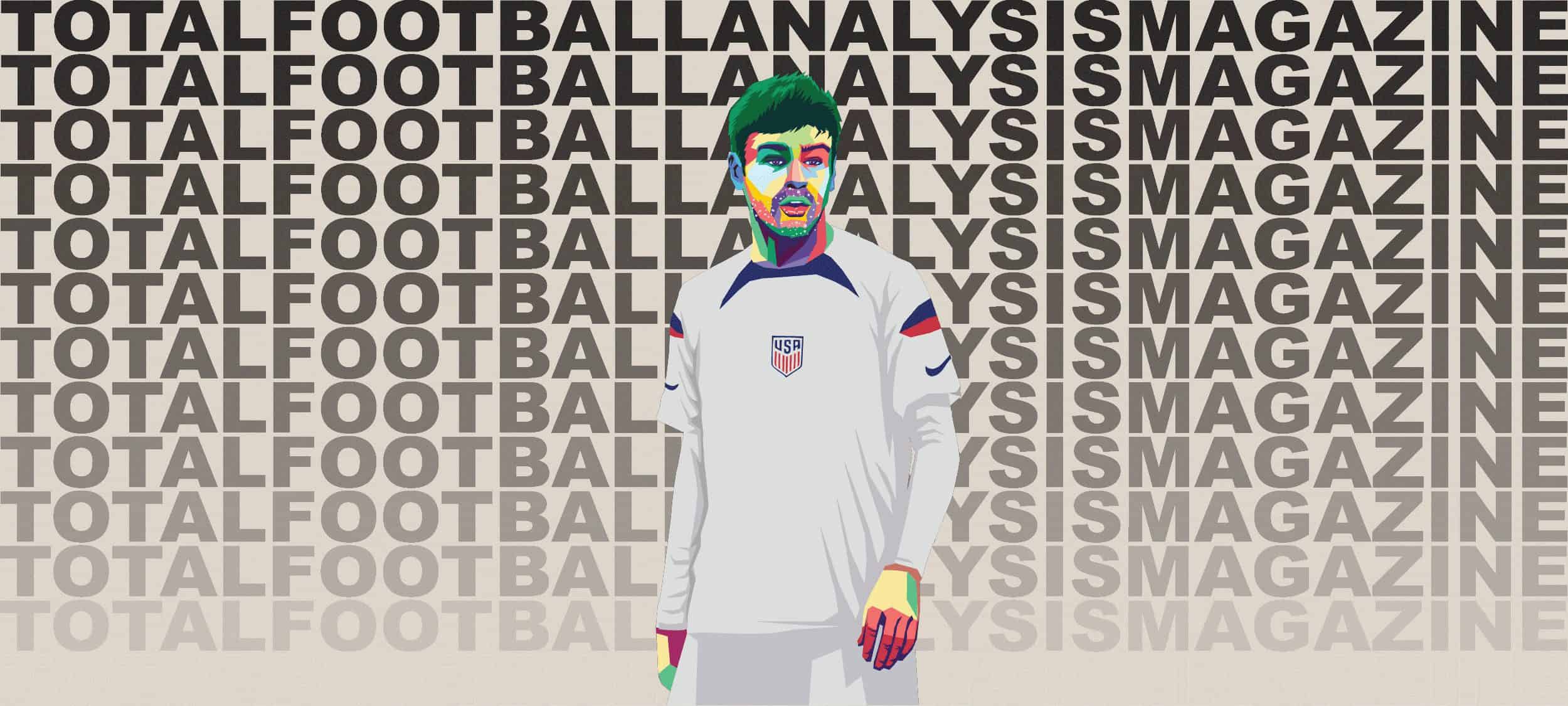



Comments